7 Best Cold Email Infrastructure Tools (2025) Trusted by Top Email Consultants
Perfect Cold Email. Zero Replies. What Went Wrong?
You don’t need another blog telling you to personalize the first line or A/B test subject lines.
You already know that.
But here’s what most people don’t tell you:
If your email infrastructure is broken, your cold email dies before it even gets seen.
Most blogs skip this.
They obsess over copy and ignore the setup.
But in this guide, you’ll learn:
- Why your emails aren’t landing, even with a perfect copy
- What infrastructure really means: DNS, warm-up, domain health, IPs
- The exact tools, consultants, and agencies used to stay out of spam
- Stack setups that actually work, whether you’re solo or managing 50 inboxes
This isn’t theory. This is what’s working in the field.
If your deliverability sucks and you don’t know why, this blog will save your next campaign.
TL;DR
Here’s a quick overview of what each tool is for:
Why Is Good Cold Email Infrastructure a Big Deal?
Cold email infrastructure is the technical setup that helps your emails reach the inbox instead of spam.
When we talk about infrastructure, we’re talking about a bundle of systems working together:
- ✅ Domains & Mailboxes: Your sending identities. Use multiple to scale safely and protect your main domain.
- ✅ SPF, DKIM, DMARC: Security protocols that verify your emails and prevent spoofing.
- ✅ Warm-Up Systems: Gradually build trust by sending low-risk emails before real cold outreach.
- ✅ Tracking Domains: Track opens/clicks without hurting deliverability—must be SSL-secured and properly linked.
- ✅ Inbox Monitoring: See if emails land in the inbox or spam. Essential for catching deliverability issues early.
- ✅ IP & DNS Configuration: Sets your sending reputation. A correct setup builds trust with Gmail, Outlook, etc.
In short:
👉 It’s the foundation that keeps your cold outreach trusted, scalable, and working properly.
Now, why does all this matter?
Because as you scale cold outreach, whether you’re sending 100 emails a day or 5,000, your email infrastructure becomes the reason why you succeed or fail.
Top email consultants will tell you this: if you’re still sending from a single Gmail and relying only on warm-up tools, you’re missing the full picture.
Strong cold email infrastructure means:
- Better inbox placement
- Higher reply rates
- Fewer bounces or blocks
- Less time fixing broken domains
In short, it gives your campaigns a reliable foundation so you can focus on messaging and targeting, not fixing problems after they happen.
7 Best Cold Email Infrastructure Providers (Trusted by the Experts)
We didn’t just throw together a random list.
➡️ We learned from consultants and dug through real user reviews on Reddit and G2.
Below are the 7 cold email infrastructure tools that consultants actually recommend in 2025, whether you’re a solo founder or running a full-scale outbound engine.
Here’s your Quick Comparison Table of 7 cold email infrastructure tools:
Here is a detailed breakdown of each tool.
1. Infraforge – End-to-End Cold Email Infrastructure for Scale
When consultants talk about scaling cold outreach in 2025, Infraforge is usually the first name that comes up.
Unlike tools that only handle warm-up, Infraforge builds the full infrastructure, domain setup, DNS, inbox rotation, warm-up, monitoring, and SSL tracking, all in one place.

Everything is managed from a single dashboard, with zero need for manual DNS changes or jumping between tools.
It’s especially trusted by:
- Agencies running outreach across dozens of inboxes
- Consultants managing infrastructure for clients
- Founders are building multi-domain setups without technical teams
Infraforge also supports outreach tools like Mailforge, allowing a smooth workflow between infrastructure setup and email sending.
What Infraforge Offers
Here’s why Infraforge is called a full-stack infrastructure tool, not just a warm-up add-on:
💼 How Consultants Use Infraforge
Most consultants use Infraforge when managing outreach for multiple clients or campaigns. For example:
- Setting up 3–5 custom domains, each with multiple inboxes
- Using Infraforge to handle SPF, DKIM, and DMARC records instantly
- Running inbox warm-up schedules for new mailboxes automatically
- Monitoring each inbox’s performance in one place (no spreadsheets or guesswork)
This kind of stack allows them to avoid blacklisting, detect issues early, and keep inboxes healthy, even with thousands of emails per week.
📣 User Feedback: Infraforge Pros and Cons

Read the full user review

Read the full user review
🔁 Integrates Easily With Sending Tools
Infraforge is designed to plug into your outreach workflow.
It works well with cold email tools like:
- Mailforge – for sending campaigns and reply handling
- Salesforge / Primeforge / Agent Frank – for multistep sequences, personalization, and AI outreach
That means you can manage domains and DNS inside Infraforge, while letting your other tools handle the messaging part.
Infraforge Pricing
Infraforge uses a modular, slot-based pricing model that scales with your needs:

Mailbox Pricing
- Base requirement: Buy a minimum of 10 mailbox slots
- Quarterly billing: $20 per mailbox/month
- Annual billing: $17 per mailbox/month
- You can rotate, delete, or recreate inboxes anytime within your slots.
Domain Pricing
- Bring your own domain: $5 per domain (setup fee)
- Buy a domain via Infraforge: $13 per domain/year
- Domains include DNS automation, SPF/DKIM/DMARC, SSL setup, and tracking configuration
🛡️ Optional Add-Ons
- SSL & subdomain masking:
- $6/domain/month (billed annually)
- $2/domain/month (billed quarterly)
- $6/domain/month (billed annually)
- Dedicated IP address:
- $99/month (quarterly billing only)
- $99/month (quarterly billing only)
- Masterbox workspace:
- $9/month (quarterly)
- $7/month (annual)
- Lets you manage all mailboxes from a single dashboard
- $9/month (quarterly)
🧾 Example Pricing Scenarios
Scenario 1: Starter Plan (10 Mailboxes + 3 Domains)
- Mailboxes (annual): 10 × $17 = $170/month
- Domains: 3 × $13/year = $3.25/month
- Total: ~$173/month
⭐ Recommendation to use Infraforge – Best When:
- You’re managing multiple domains and inboxes
- You need hands-free DNS, SPF, DKIM, and DMARC
- You want automated warm-up + health monitoring
- You’re scaling cold outreach, not just testing it
- You prefer tools that just work without hacks
🧠 Smart Tip:
Use separate tracking domains for each campaign or client.
This helps protect the sender's reputation. If one domain gets flagged, others stay unaffected, which is a common best practice among consultants managing at scale.
Our Verdict
Infraforge is not just another warm-up tool. It’s the engine that supports serious outbound teams.
Consultants rely on it because it solves the hardest part of scaling cold email, the tech infrastructure that most tools skip.
Whether you’re managing 5 inboxes or 50, Infraforge keeps deliverability under control.
✅ Want to Try Infraforge?
You don’t need a developer or an agency to get started.
Infraforge lets you set up your full cold email infrastructure, including domains, inboxes, SPF/DKIM/DMARC, and warm-up, in under 10 minutes.
No credit card. No DNS guesswork. Just working on cold email infrastructure.
👉 Explore Infraforge here
2. Mailforge – Smart Warm-Up & Inbox Control for Cold Emailers
If Infraforge is your backend infrastructure, Mailforge is the hands-on control center for sending and scaling cold emails.
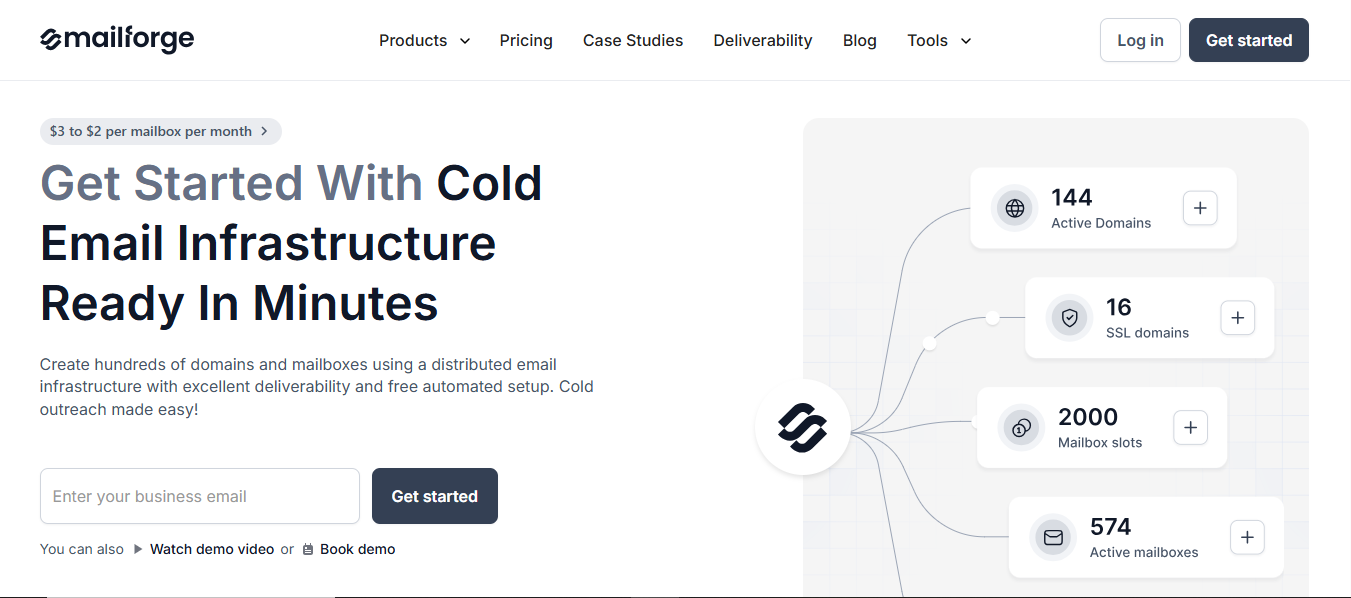
Consultants often recommend Mailforge to teams who already have infrastructure (like domains and DNS) handled, and now need precise control over warm-up pacing, inbox reputation, reply handling, and sending automation.
What Mailforge Offers
Here’s how Mailforge complements infra tools and delivers precise control:
User Feedback: Mailforge Pros and Cons

Read the full user review

Read the full user review
Mailforge Pricing
Mailforge follows a flat-rate pricing model based on the number of inboxes:
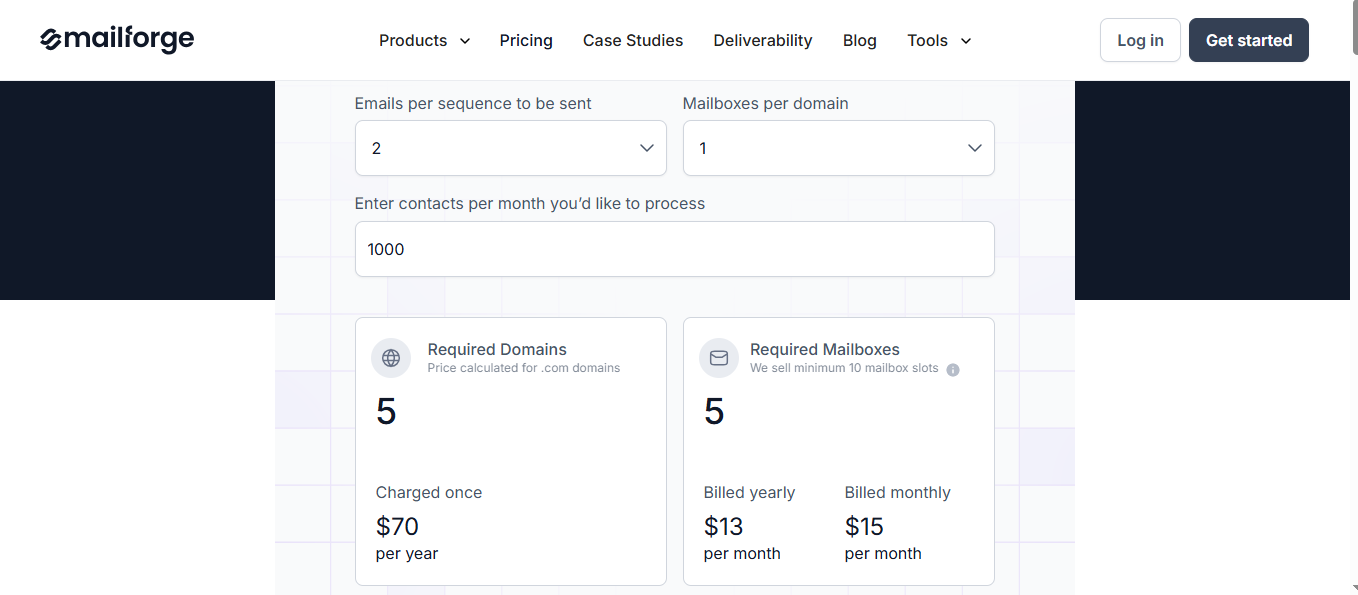
Mailbox-Based Pricing
- Starter: $29/month for up to 10 inboxes
- Pro: $59/month for up to 25 inboxes
- Agency: $99/month for 50 inboxes
- Custom Plans: Available for 100+ inboxes (contact support)
Each plan includes:
- Warm-up simulation
- Spam placement analytics
- Folder monitoring
- Email behavior control
- SMTP & Gmail/Outlook integration
🧾 Example Pricing Scenarios
⭐ Recommendation to use Mailforge – Best When:
- You already have DNS and domain setup sorted
- You want inbox-level warm-up control and pacing
- You’re managing 10+ inboxes across clients or campaigns
- You need reply simulation and inbox health insights
- You’re scaling and want to avoid generic warm-up issues
It’s often picked by consultants who want flexibility without touching infrastructure again.
Mailforge handles the warm-up logic, reply timing, and performance tracking with precision.
🧠 Smart Tip
Warm-up volume isn’t “set and forget.”
Consultants recommend starting low (5–10 emails/day) and increasing gradually, especially if your domain is new or your sender reputation is unknown.
Our Verdict
Mailforge is the tool consultants reach for when infrastructure is already sorted. It delivers unmatched control over warm-up pacing, reply simulation, and inbox monitoring, without unnecessary complexity.
Ideal for teams managing 10+ inboxes, it’s built for serious, scalable warm-up. Clean, efficient, and dependable.
3. Instantly – Cold Email Platform With Optional Infrastructure Setup
Instantly is primarily a cold email sending tool. But with manual setup, it can handle parts of your infrastructure, like SMTP, tracking domains, and warm-up. Just note: it’s not plug-and-play.
You’ll need to handle SPF, DKIM, and other DNS settings yourself.

This makes it powerful for experienced users, but less ideal for beginners or teams looking for a fully managed setup.
🔧 What Instantly Offers
User Feedback: Instantly Pros and Cons

Read the full user review

Read the full user review
Instantly Pricing

- Free Trial: includes accounts and warm-up
- Growth: $37/month – warm-up, outreach, basic AI
- Supersonic: $97/month – 5k–7.5k credits, full feature set
- Hyper Credits: $197/month – 10k–200k credits
- Enterprise: Custom pricing, dedicated support
- Annual billing saves ~20%
⭐ Recommendation to use Instantly – Best When:
- You want campaigns + warm-up in one platform
- You’re comfortable doing manual DNS or SMTP setup
- You need high-volume sending with custom SMTP
- You don’t need full infrastructure; just control
- You have a dev or technical co-founder
It’s a flexible tool, but it requires more setup and maintenance compared to Infraforge or similar full-stack infra tools.
🧠 Smart Tip:
Always verify DNS records after setting up SMTP.
Missing or incorrect SPF/DKIM/DMARC is a top reason why emails land in spam. Use external tools or Infraforge to validate them before sending.
Our Verdict
Instantly is not a full infrastructure solution by default, but it offers flexibility for those who can handle the technical setup.
It’s best for users who want to manage everything in one place but don’t mind doing extra configuration behind the scenes.
4. Maildoso – Fast Domain + Mailbox Setup for Cold Outreach
Maildoso is built for speed. It’s designed to help cold outreach teams get domains, mailboxes, and warm-up flows live in under 15 minutes, without touching DNS panels.

Unlike traditional tools that require manual domain registration, mailbox setup, and warm-up configuration, Maildoso automates everything.
You enter your sending volume and targets, and the platform handles the rest, from buying the domain to configuring DNS, email routing, and even warm-up sequences.
🔧 What Maildoso Offers
Maildoso shines in onboarding speed and fully managed infrastructure. Here’s what you get:
User Feedback: Maildoso Pros and Cons

Read the full user review

Read the full user review
Maildoso Pricing
Maildoso keeps things simple; everything is packaged based on the number of inboxes and domains you need. Here's how pricing breaks down:

Mailbox Pricing
- Minimum of 10 mailbox slots
- $20/month per inbox (billed quarterly)
- $17/month per inbox (billed annually)
Domain Pricing
- Bring your own domain: $5 setup per domain
- Buy a domain via Maildoso: $13/year
- Includes full DNS + SPF/DKIM/DMARC configuration
Optional Add-Ons
- SSL masking: $6/month per domain (annual) or $2/month (quarterly)
- Dedicated IP: $99/month (quarterly only)
- Master workspace: $9/month (quarterly) or $7/month (annual)
Example Plan:
Launching 3 domains and 15 inboxes
👉 Cost: ~$275/month all-in
⭐ Recommendation to Use Maildoso – Best When:
- You need to launch inboxes fast (same day)
- You don’t want to touch DNS or domain dashboards
- You’re working on project-based campaigns
- You need temporary infrastructure that works
- You prefer all-in-one setup (domain + mailbox + warm-up)
🧠 Smart Tip:
If you’re using Maildoso for short-term inboxes, don’t skip domain masking.
Adding SSL + subdomain tracking can make a major difference in how your emails land across Gmail and Outlook.
🧠 Our Verdict
Maildoso is built for speed and simplicity. It’s not the most customizable infrastructure tool, but it doesn’t need to be.
If your priority is getting 10+ inboxes live without dealing with DNS or tech hassles, this is one of the fastest tools available.
Consultants use it for quick launches, test campaigns, and short-term outreach setups where agility matters more than control.
5. Mailreach – Trusted for Warm-Up, But Not Full Infrastructure
Mailreach is a go-to tool for inbox warm-up and early-stage sender reputation. It automates warm-up emails, simulates real replies, and shows basic inbox placement metrics. But that’s where it stops.
It doesn’t handle DNS setup (SPF, DKIM, DMARC), custom domains, or infrastructure monitoring, so you’ll need other tools if you want full control.

So if you’re just starting with one or two inboxes and want to build trust with Gmail or Outlook, Mailreach is a solid option.
🔧 What Mailreach Offers
User Feedback: Mailreach Pros and Cons

Read the full user review

Read the full user review
Mailreach Pricing

- Monthly: $25/mailbox, includes warm-up (~90 emails/day)
- Annual “Scale” plan: $19.50/mailbox for 6–100 mailboxes
- Add-ons:
- Spam test credits are available separately
⭐ Recommendation to use Mailreach – Best When:
- You’re warming 1–2 inboxes quickly
- You don’t want to touch DNS or technical settings
- You need a simple, no-fuss warm-up
- You’re prepping inboxes for tools like Instantly or Lemlist
- You only care about reputation, not full infrastructure
It’s seen as a plug-and-play warm-up tool, especially for solopreneurs or junior teams that don’t need advanced features yet.
🧠 Smart Tip:
Turn off other warm-up tools while using Mailreach.
Running two warm-up systems at once can confuse spam filters and lower deliverability. Stick to one per inbox for cleaner results.
Our Verdict
Mailreach is a strong choice for inbox warm-up, but not a complete cold email infrastructure solution.
It lacks DNS automation, domain control, and inbox health visibility at scale.
That makes it best for warming individual mailboxes, not powering a full outreach engine.
6. Folderly – Premium Diagnostic and Deliverability Consultant Tool
Folderly is known for deep email deliverability diagnostics, spam issue detection, and expert guidance.
Consultants and marketing teams often use Folderly when their emails start landing in spam, even after warm-up and proper domain setup.
It’s a tool built for finding hidden issues.
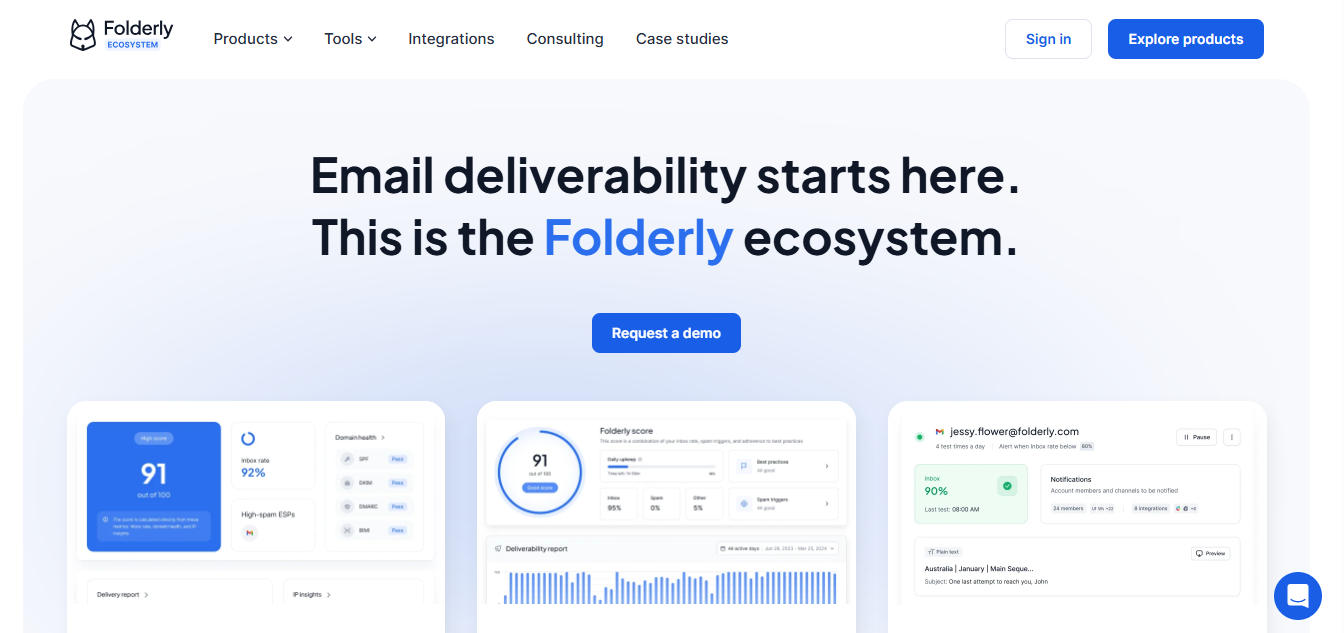
If you already have your cold email system running but see inconsistent deliverability, Folderly helps analyze inbox placement, scan your domain for issues, and even offers tailored consulting.
🔧 What Folderly Offers
User Feedback: Folderly Pros and Cons

Read the full user review

Read the full user review
Folderly Pricing
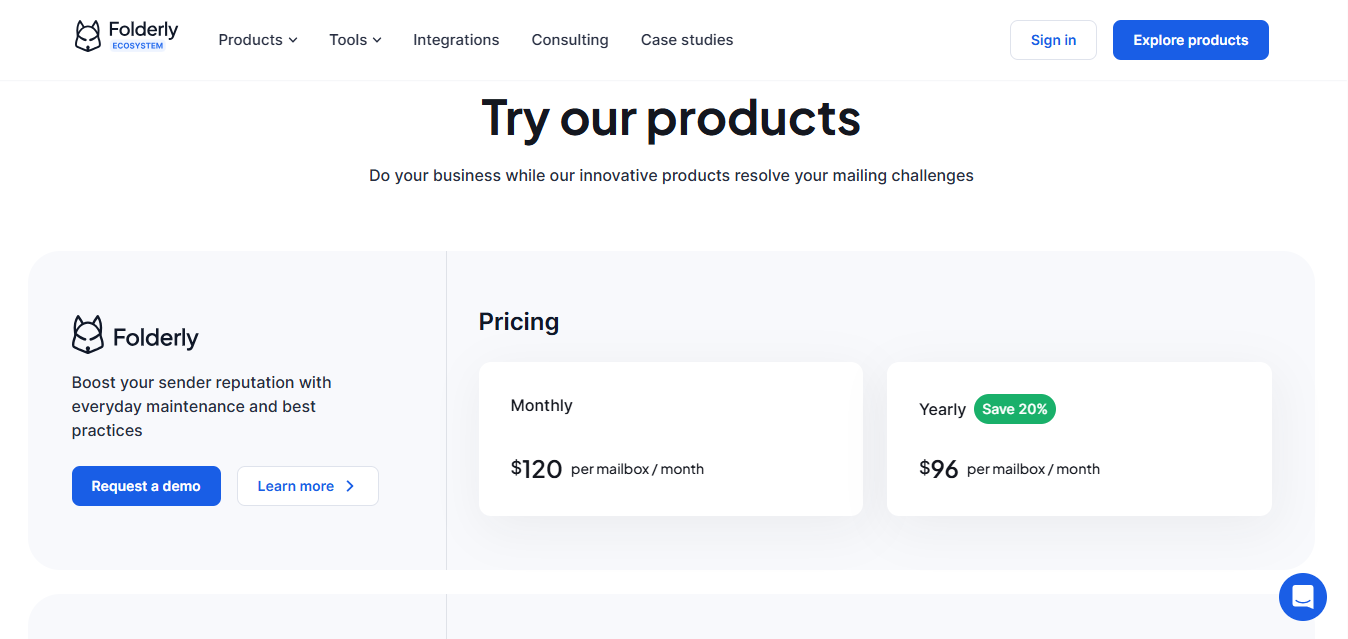
- Monthly: $120/mailbox
- Annual: $96/mailbox (20% savings)
- Free plan: 2 spam/deliverability tests per month
- All tiers include audits, DNS/template support, and team dashboards
⭐ Consultants' Recommendation to use Folderly – Best when:
- Your emails are hitting spam
- You need deliverability experts, not just software
- You already have infrastructure, but you need deeper analysis
- You want personalized audits and reports
- You’re fixing, not scaling
While it's not built for domain management or DNS setup, Folderly often becomes part of a diagnostic stack alongside tools like Infraforge or GlockApps.
🧠 Smart Tip: Folderly
Run their spam audit first, before changing DNS or copying.
Folderly excels at pinpointing specific issues. Use their diagnostics to fix the right problem instead of guessing.
Our Verdict
Folderly is a strong choice when you need deliverability help, not infrastructure.
Consultants use it for audits, testing, and resolving hidden inbox problems. But for cold email setup, domain rotation, or DNS configuration, you’ll need another tool in your stack.
7. GlockApps – Inbox Placement Testing and Spam Trap Detection
GlockApps plays a critical role in cold email infrastructure by testing inbox placement across major providers like Gmail, Outlook, and Yahoo.
It also scans for spam triggers, blacklist status, and authentication problems (SPF, DKIM, DMARC), helping teams fix unseen problems that can quietly damage sender reputation.

🔧 What GlockApps Offers
User Feedback: GlockApps Pros and Cons

Read the full user review

Read the full user review
GlockApps Pricing
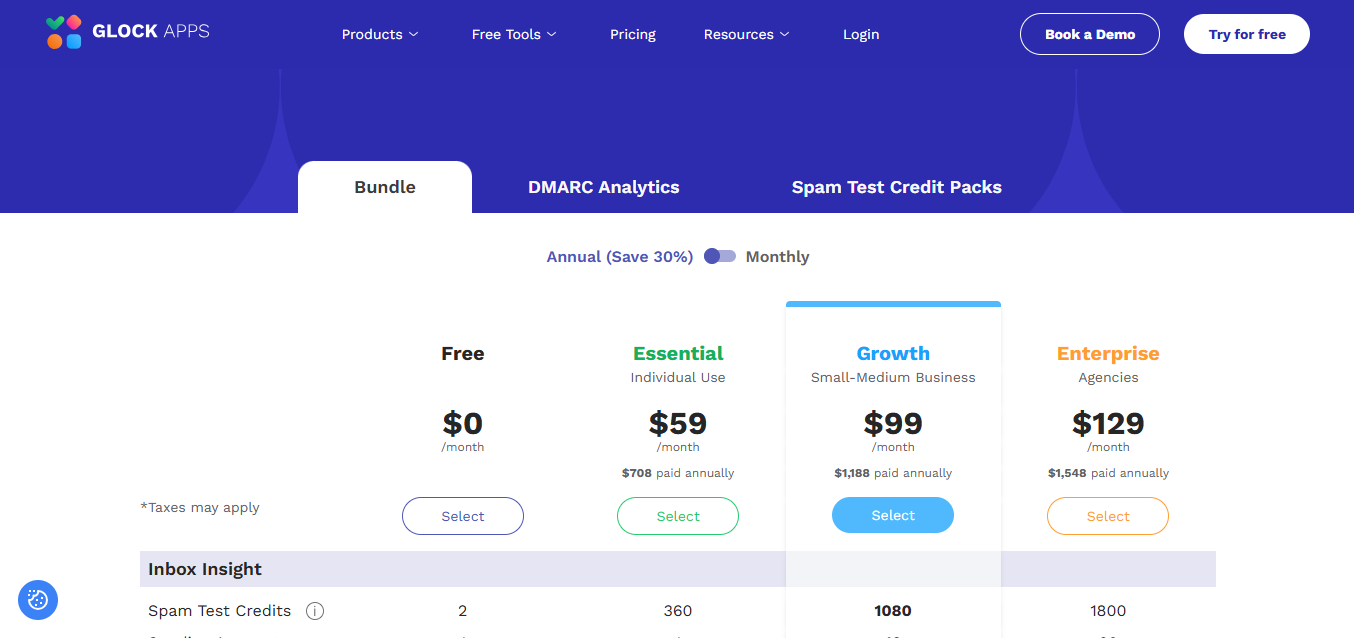
- Free: 2 spam tests + 10K DMARC credits
- Paid tiers: from $59/month up to $207/month, depending on bundle:
- Spam Testing
- DMARC Analytics
- Automation and Uptime Monitoring
- Spam Testing
⭐ Recommendation to use GlockApps – Best When:
- You want to check the inbox placement before sending
- You need to test if you’re on a blacklist
- You’re validating DNS records or spam triggers
- You already have the infrastructure, just need testing
- You want to test, not send
It’s not something you use every day, but it helps catch red flags before they impact outreach.
🧠 Smart Tip:
Test different versions of your email before campaigns.
Change subject lines, sender names, and links. GlockApps helps identify content or formatting triggers that land you in spam.
Our Verdict
GlockApps is essential for diagnostics, but not a replacement for infrastructure tools.
It gives visibility into your email health, which is why consultants often use it with tools like Infraforge or Folderly to complete the setup.
The Cold Email Infra Checklist Used by Top Consultants
1. Domain & Mailbox Scaling
- Can you add and manage multiple domains easily?
- Can you rotate inboxes to protect your main domain?
2. Deliverability Monitoring
- Does it show inbox placement (Gmail, Outlook, etc.)?
- Does it track spam score and mailbox health clearly?
3. IP Reputation Control
- Can you choose between shared and dedicated IPs?
- Does the tool show who you’re sharing IPs with (if any)?
4. Warm-Up Automation
- Does it send warm-up emails with real-like behavior?
- Does it include opens, replies, and gradual ramp-up?
5. Tracking Domain Management
- Can you add custom tracking domains?
- Does it support SSL to avoid trust issues?
- Can you avoid blacklisted shared tracking links?
6. Cold Email Tool Compatibility
- Does it integrate with tools like Lemlist, Mailforge, Instantly, etc.?
- Can you sync inboxes and settings in a few clicks?
7. Ease of Use & Support
- Can you get started without a technical setup?
- Is support responsive when something breaks?
Consultant-Recommended Stack Examples (Real Workflow Setups)
Choosing a cold email infrastructure tool is only one part of the process.
Top email consultants usually combine tools into stack setups, each built for a different stage of cold email growth.
Here are three expert-approved stacks based on real-world use cases:
🔹 Beginner Setup
Best for: Solo founders or small teams warming their first inboxes
Tools Used:
- Infraforge → DNS automation + warm-up with inbox monitoring
- GlockApps → Inbox placement testing before outreach starts
Why it works:
Infraforge automates all the technical setup, SPF, DKIM, DMARC, and warming, so beginners don’t have to dig into DNS.
GlockApps adds a quick inbox score check before campaigns begin.
🔹 Scaling Agency Setup
Best for: Agencies or consultants managing 10–50 inboxes across domains
Tools Used:
- Infraforge → Domain rotation, DNS records, automated warm-up, inbox monitoring
- Mailforge → Precise warm-up control, reply simulation, per-inbox pacing
- GlockApps → Health testing for inboxes and domain-level deliverability tracking
Why it works:
Infraforge handles back-end infra at scale. Mailforge gives granular warm-up control on each inbox.
GlockApps adds inbox placement visibility to detect early reputation issues.
🔹 Troubleshooting & Recovery Setup
Best for: When inboxes get flagged, emails hit spam, or open rates suddenly drop
Tools Used:
- Infraforge → Check domain health, SPF/DKIM/DMARC issues, or warm-up gaps
- Folderly → Spam trigger audits, placement heatmaps, sender score tracking
- Maildoso → Hosted inbox setup + warm-up reset across new domains
Why it works:
Infraforge shows root infra-level issues.
Folderly reveals hidden spam flags. Maildoso helps restart campaigns on clean, warmed-up inboxes if older ones are burned.
📊 Cold Email Infrastructure Stack: Quick Comparison Table
Which Cold Email Infrastructure Should You Choose?
Not every team needs a full-blown email infrastructure. Here’s a simple table to help you pick the right tool based on your current setup, goals, and technical bandwidth.
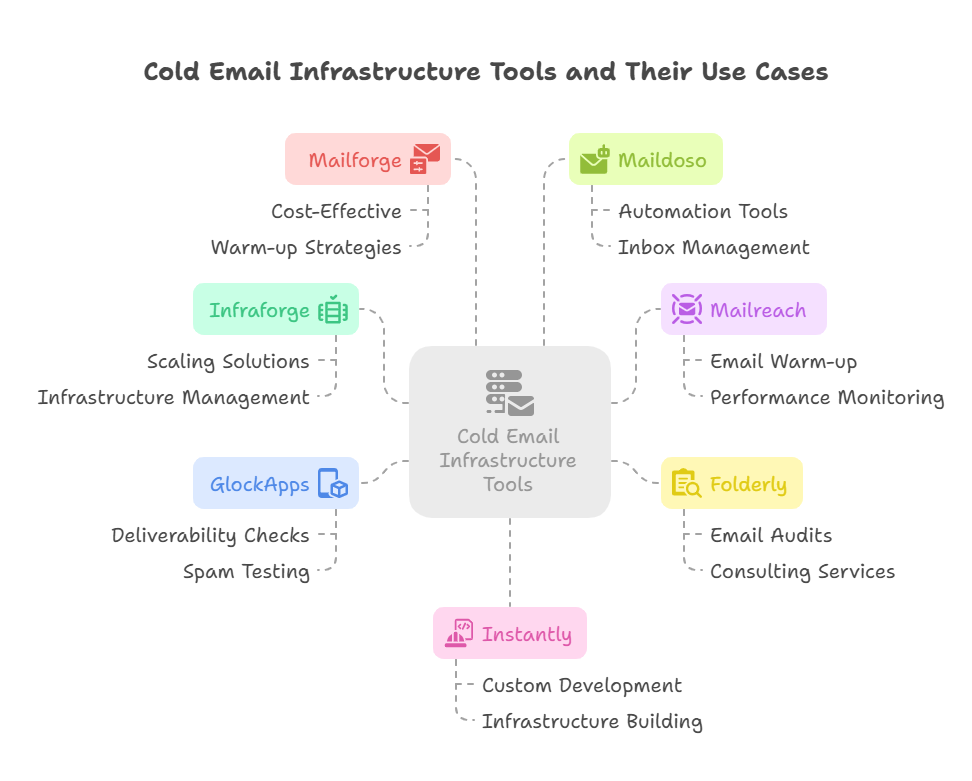
✨ Pro Tip for Founders & Consultants:
If you're scaling fast or managing clients, start with Infraforge as your infra backbone and Mailforge for sending sequences.
Add GlockApps or Folderly for extra monitoring.
💡 Tips from Consultants: How to Avoid Infrastructure Mistakes
Here’s what seasoned email consultants recommend after fixing hundreds of deliverability issues. These aren’t theories, they’re hard-learned lessons.
Consultant Tips Table: Avoid Cold Email Infrastructure Mistakes
Final Verdict: What Consultants Look for in Email Infrastructure
Not every team needs full-stack control. But the ones that scale reliably and avoid deliverability issues tend to choose tools built for infrastructure, not just warm-up.
Here’s what usually tips the decision toward Infraforge:
- Clear visibility into DNS records, blacklist status, and IP rotation
- Simple to manage 10 to 100+ inboxes without tool sprawl
- Avoids surprises, alerts before inboxes go cold
- No fluff: just the essentials for uptime and sender reputation
- Supports teams who prefer control over one-size-fits-all software
Infraforge stands out when outreach is more than a side task.
If you’re running 30+ inboxes or managing multiple domains, consultants often recommend starting here, not because it’s flashier, but because it holds up at scale.